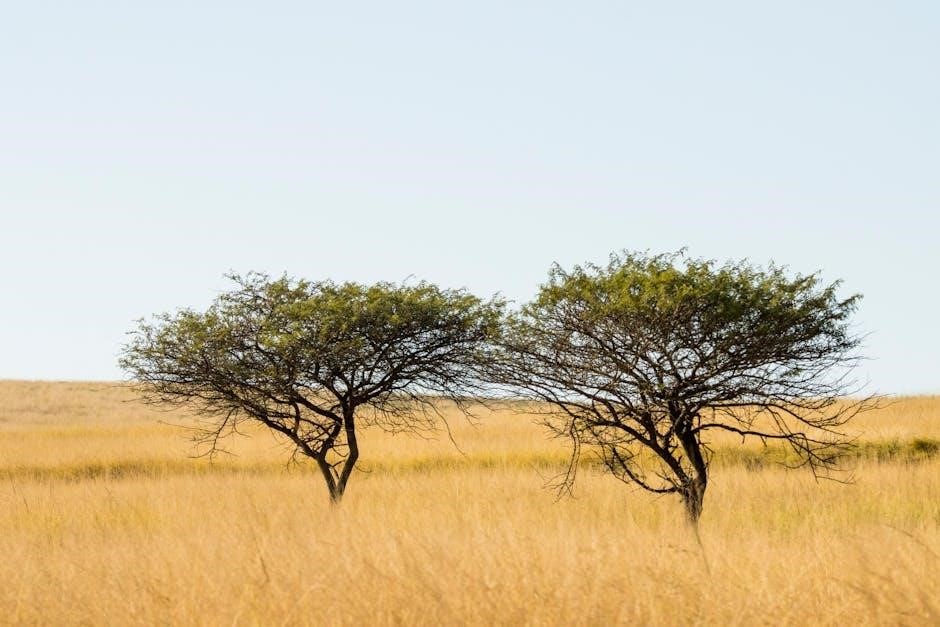Wilderness Medicine is a specialized field addressing medical emergencies in remote, non-traditional settings․ This portable guide covers diagnosis, treatment, and prevention of various wilderness-related conditions and injuries effectively․
1․1 Definition and Scope of Wilderness Medicine
Wilderness Medicine is a specialized field of medical practice focused on addressing emergencies in remote, non-traditional settings where access to advanced care is limited․ It encompasses the diagnosis, treatment, and prevention of injuries and illnesses occurring in wilderness environments․ The scope includes managing diverse medical situations, such as wounds, fractures, and environmental exposures, while emphasizing resourcefulness and improvisation․ Wilderness Medicine also involves understanding the unique challenges of varying terrains, climates, and limited resources․ It equips practitioners with the skills to deliver effective care in austere conditions, ensuring patient safety and stability until professional help is available․
1․2 Importance of Wilderness Medicine in Remote Settings
Wilderness Medicine is crucial in remote areas where medical resources are scarce and access to hospitals is limited․ It ensures timely and effective care for injuries and illnesses, preventing minor issues from escalating․ By addressing conditions like altitude sickness, hypothermia, and trauma, it reduces mortality rates․ Wilderness Medicine also promotes preparedness and self-reliance, empowering individuals to manage emergencies independently․ Its principles are vital for outdoor enthusiasts, rescue teams, and communities in isolated regions, fostering resilience and improving outcomes in challenging environments․

Preparation and Prevention
Preparation and prevention are key to minimizing risks in wilderness settings․ Essential items and strategies help prevent injuries and illnesses, ensuring safer outdoor experiences and timely interventions․
2․1 Essential Items for a Wilderness First Aid Kit
A well-stocked wilderness first aid kit is crucial for managing injuries and preventing infections․ Include bandages, antiseptic wipes, pain relievers, gloves, and a first aid manual․ Add items like blister care, personal protective equipment, and any personal medications․ Tailor the kit to the environment and trip duration for optimal preparedness and emergency response․
2․2 Preventive Measures for Common Wilderness Injuries
Preventing wilderness injuries begins with proper preparation and awareness․ Wear protective clothing, such as sturdy boots and long sleeves, to shield against rough terrain and plants․ Use navigation tools like maps and GPS to avoid getting lost, reducing the risk of accidents․ Check weather conditions to prevent exposure-related issues․ Ensure proper footwear to minimize blisters and sprains․ Stay hydrated to avoid dehydration-related complications․ Assess risks before engaging in activities, such as avoiding unstable terrain or fast-moving water․ Carry a first aid kit and know basic first aid techniques to address minor injuries before they escalate․
Common Wilderness Injuries
Common wilderness injuries include cuts, fractures, sprains, burns, and blisters, often resulting from accidents or environmental exposures․ Prompt care is crucial to prevent infection and complications․
3․1 Wound Care in the Field
Proper wound care in the field is essential to prevent infection and promote healing․ Start by assessing the wound for debris or foreign objects․ Clean the area with sterile or clean water, avoiding harsh chemicals․ Pat dry with a clean cloth and apply antiseptic ointment if available․ Cover the wound with a sterile bandage or dressing to protect it from further contamination․ Monitor for signs of infection, such as redness, swelling, or pus․ Change dressings daily or as needed․ If the wound is deep or shows signs of infection, seek professional medical help promptly․
3․2 Management of Fractures and Sprains
Managing fractures and sprains in the field requires immediate and careful attention․ For fractures, immobilize the affected limb using a splint or sling to prevent further injury․ Apply the RICE method—Rest, Ice, Compression, Elevation—to reduce swelling and pain․ For sprains, follow the same RICE principles, focusing on immobilizing the joint․ Monitor circulation and neurological function, ensuring no numbness or tingling․ Administer pain relievers if available and avoid putting weight on the injured area․ If the injury is severe or worsening, prioritize evacuation to a medical facility for professional treatment․
3․3 Treatment of Burns in Wilderness Conditions
Treating burns in the wilderness requires immediate action to minimize damage; Cool the burn with clean water for 10-15 minutes to reduce temperature and pain․ Remove any clothing or jewelry near the burn to prevent further injury․ Clean the area with sterile water and apply an antimicrobial ointment to prevent infection․ Cover the burn with a non-stick dressing or clean cloth․ For severe burns (charred skin or covering a large area), prioritize evacuation․ Monitor for signs of infection, such as redness or swelling, and manage pain with available medications․ Ensure the patient stays hydrated and warm to avoid shock․

Environmental Exposures
Environmental exposures pose significant risks in wilderness settings, including extreme temperatures, altitude sickness, and weather-related hazards․ Recognition and management of these conditions are critical to preventing severe outcomes․
4․1 Altitude Sickness: Recognition and Treatment
Altitude sickness occurs when the body cannot adapt to high elevations, leading to symptoms like headaches, nausea, and fatigue․ Recognizing early signs is crucial for effective treatment․ Mild cases may improve with rest, hydration, and over-the-counter pain relievers․ Severe symptoms, such as confusion or shortness of breath, indicate life-threatening conditions like HAPE or HACE, requiring immediate descent and medical attention․ Acclimatization strategies, such as gradual ascent, can prevent altitude sickness․ Medications like acetazolamide may be prescribed for prophylaxis․ Always monitor for worsening symptoms and prioritize evacuation if necessary to ensure safety in high-altitude environments․
4․2 Hypothermia and Heat-Related Illnesses
Hypothermia occurs when body temperature drops below 95°F, causing shivering, confusion, and eventual loss of consciousness․ Treatment involves rewarming the person with blankets, warm fluids, and body heat․ Heat-related illnesses, such as heat exhaustion and heatstroke, arise from excessive exposure to high temperatures․ Symptoms include dizziness, sweating, and elevated body temperature․ Heatstroke is life-threatening and requires immediate cooling․ Prevention involves wearing appropriate clothing, staying hydrated, and avoiding strenuous activity during extreme weather․ Recognizing early signs and acting promptly is critical to managing these conditions effectively in wilderness settings․
4․3 Lightning Strikes and Electrical Injuries
Lightning strikes are rare but catastrophic events, causing cardiac arrest, burns, and neurological damage․ Immediate care involves ensuring scene safety, as lightning can strike the same location multiple times․ Provide cardiopulmonary resuscitation (CPR) if the victim is unresponsive, as cardiac arrest is common․ Assess for burns and treat accordingly․ Move the victim to a safe location and monitor for developing symptoms, as injuries may evolve․ Seek professional medical help promptly, as lightning injuries often require specialized care․ Prevention includes monitoring weather conditions and seeking shelter during storms․

Wilderness-Specific Medical Conditions
This section explores unique medical challenges in remote environments, including high-altitude illnesses, venomous injuries, and extreme weather-related conditions, offering practical solutions for diagnosis and treatment․
5․1 High-Altitude Pulmonary Edema (HAPE) and Cerebral Edema (HACE)
HAPE and HACE are severe altitude-related conditions․ HAPE involves fluid buildup in the lungs, causing coughing and shortness of breath, while HACE leads to swelling of the brain, resulting in confusion and loss of coordination․ Both conditions are life-threatening and require immediate descent to lower altitudes․ Symptoms include fatigue, headaches, and nausea․ Early recognition is crucial, as delayed treatment can be fatal․ Portable hyperbaric chambers may stabilize patients temporarily, but evacuation to a medical facility is essential for recovery․
5․2 Acute Mountain Sickness (AMS): Diagnosis and Management
Acute Mountain Sickness (AMS) occurs when the body cannot adapt to high altitudes, leading to symptoms like headaches, nausea, and fatigue․ Diagnosis is based on clinical assessment and altitude exposure history․ Mild AMS can be managed with rest, hydration, and over-the-counter pain relievers․ Severe cases require immediate descent to lower altitudes․ Portable hyperbaric chambers may alleviate symptoms temporarily․ Preventive measures include gradual ascent and acclimatization․ Early recognition is critical, as untreated AMS can progress to life-threatening conditions like HAPE or HACE․ Proper field management ensures timely intervention and improves outcomes in remote settings․
5․3 Snake Bites and Venomous Injuries
Suspected snake bites require immediate attention․ Stay calm, remove constrictive items, and immobilize the affected limb below heart level․ Avoid tourniquets or sucking venom, as these methods are ineffective․ Clean the wound with soap and water, and cover it with a sterile dressing․ If possible, identify the snake without provoking it, as this aids in treatment․ Transport the victim to a medical facility promptly․ Treatment may involve antivenom administration, depending on the species and bite severity․ Proper field management reduces complications and improves outcomes in remote wilderness settings․

Infectious Diseases in the Wilderness
Infectious diseases in wilderness settings include waterborne, foodborne, and vector-borne illnesses․ Prevention focuses on safe drinking water, proper hygiene, and insect repellents to minimize disease transmission risks․
6․1 Prevention of Waterborne and Foodborne Illnesses
Preventing waterborne and foodborne illnesses in the wilderness is crucial for maintaining health․ Always use water filtration systems, chemical disinfection, or boiling to ensure safe drinking water․ Avoid consuming untreated water from streams or lakes, as it may contain harmful pathogens like Giardia or Cryptosporidium․ When handling food, opt for non-perishable items and store them properly to prevent spoilage․ Wash hands thoroughly with soap and clean water before eating or preparing meals․ Proper hygiene and food storage techniques significantly reduce the risk of contracting waterborne and foodborne diseases in remote settings․
6․2 Tick-Borne Diseases: Lyme Disease and Others
Tick-borne diseases, such as Lyme disease, pose significant risks in wilderness environments․ Lyme disease, transmitted by the bite of infected black-legged ticks, often presents with fever, fatigue, and a characteristic “bull’s-eye” rash․ If untreated, it can lead to serious complications like arthritis or neurological issues․ Prevention is key: wear protective clothing, use insect repellents, and conduct regular tick checks․ Prompt removal of attached ticks within 36 hours can prevent infection․ Awareness of tick habitats and behaviors is essential for minimizing exposure and ensuring timely medical intervention if symptoms arise during or after wilderness excursions․
6․3 Malaria and Other Mosquito-Borne Diseases
Mosquito-borne diseases like malaria, dengue, Zika, and yellow fever are significant risks in wilderness areas․ Malaria, transmitted by Anopheles mosquitoes, causes fever, chills, and flu-like symptoms, potentially leading to severe complications․ Prevention involves insect repellents, protective clothing, and mosquito nets․ Prophylactic medications are essential for malaria-prone regions, while vaccines are available for yellow fever․ Early diagnosis and treatment are critical, as delays can result in severe outcomes․ Understanding mosquito behavior and habitats is vital for minimizing exposure and ensuring timely medical intervention in remote settings․

Mental Health in Wilderness Settings
Wilderness environments often trigger mental health challenges due to isolation and stress․ Recognizing anxiety and psychotic episodes is crucial․ Mental preparedness and resilience are key to managing these issues effectively․
7․1 Assessing and Managing Panic and Anxiety
Assessing panic and anxiety in wilderness settings requires immediate attention to prevent escalation․ Recognize signs like rapid breathing, trembling, and irrational fears․ Use calm communication and active listening to reassure the individual․ Employ grounding techniques, such as focusing on the present moment, to reduce distress․ Encourage relaxation exercises like deep breathing or mindfulness to stabilize emotions․ If symptoms persist or worsen, consider evacuation to a safer environment for professional intervention․ Prioritize emotional well-being to maintain group stability and ensure safe continuation of the wilderness experience․ Proper management can prevent long-term psychological impacts and foster resilience․
7․2 Recognizing and Responding to Psychotic Episodes
Psychotic episodes in wilderness settings are rare but critical to manage․ Recognize symptoms like hallucinations, disorganized thinking, or detachment from reality․ Stay calm and ensure the individual’s safety, removing access to harmful objects․ Avoid confrontation; instead, use gentle, reassuring communication․ If the person becomes violent or unmanageable, prioritize group safety and secure the environment․ Administering sedatives may require professional guidance․ Monitor closely for dehydration or exhaustion, as psychosis can stem from environmental stressors․ If symptoms persist or worsen, immediate evacuation to a medical facility is essential․ Always prioritize safety and seek expert help when possible․

Legal and Ethical Considerations
Wilderness medicine involves navigating legal and ethical challenges․ Providers must balance Good Samaritan laws, patient consent, and resource limitations while adhering to ethical standards in remote care settings․
8․1 Good Samaritan Laws and Liability
Good Samaritan laws protect individuals providing emergency aid in good faith, without expectation of compensation, from liability․ These laws vary by jurisdiction but aim to encourage bystanders to assist in crises․ In wilderness settings, where medical resources are limited, understanding these protections is crucial․ Generally, liability arises only if gross negligence or willful misconduct occurs․ Wilderness medicine practitioners must balance acting in good faith with adhering to their training and scope of practice․ This legal framework helps ensure timely care in remote areas while safeguarding both providers and recipients․
8․2 Ethical Dilemmas in Wilderness Medicine
Wilderness medicine often presents ethical dilemmas due to limited resources and remote settings․ Providers may face tough decisions, such as rationing supplies or prioritizing patients․ Triage in resource-scarce environments requires balancing individual needs with group safety․ Additionally, the lack of advanced care options raises questions about the extent of intervention․ Ethical frameworks guide practitioners to act in patients’ best interests while minimizing harm․ Sound judgment and adherence to ethical principles are essential in resolving these challenges effectively, ensuring compassionate and responsible care in austere conditions․ These dilemmas highlight the complexities of medical practice in non-traditional settings․
When to Evacuate
Evacuation is crucial when severe injuries, altitude sickness, or life-threatening conditions arise, ensuring timely medical intervention to prevent further complications in remote settings․
9․1 Signs and Symptoms Requiring Immediate Evacuation
Severe injuries, such as head trauma, spinal cord damage, or heavy bleeding, necessitate immediate evacuation․ Symptoms like severe chest pain, difficulty breathing, or altered mental status also require prompt action․ High-altitude pulmonary edema (HAPE) or cerebral edema (HACE) are critical conditions demanding urgent evacuation․ Additionally, severe burns, anaphylaxis, or snake bites with systemic effects warrant rapid removal from the wilderness․ Recognizing these signs ensures timely intervention, preventing further complications and improving patient outcomes in remote settings․ Always prioritize evacuation when life-threatening conditions arise․
9․2 Coordination with Rescue Teams and Emergency Services
Effective coordination with rescue teams and emergency services is crucial in wilderness medicine․ Establish clear communication using GPS coordinates, satellite phones, or two-way radios to convey the situation and location․ Designate a team member to act as a liaison, ensuring seamless information flow․ Prepare the patient and site for evacuation, following rescue team instructions․ Use visual signals or markers to guide rescuers․ Maintain detailed documentation of the incident and medical interventions․ Collaboration between field teams and emergency services ensures efficient and safe evacuations, minimizing risks and improving patient outcomes in remote settings․
Wilderness Medicine empowers practitioners to address emergencies in remote settings․ This guide provides essential knowledge, promoting preparedness and resilience to save lives in challenging environments effectively․
10․1 Summary of Key Principles
Wilderness Medicine emphasizes preparedness, rapid assessment, and effective treatment in remote settings․ Key principles include early recognition of altitude sickness, hypothermia, and injuries, along with proper wound care․ Utilizing a well-stocked first aid kit and understanding environmental risks is crucial․ Prevention strategies, such as avoiding waterborne illnesses and tick-borne diseases, play a significant role․ Evacuation decisions should be made promptly when conditions exceed field management capabilities․ This guide underscores the importance of mental health, ethical considerations, and coordination with rescue teams to ensure optimal outcomes in wilderness emergencies․ These principles form the backbone of effective wilderness medical practice․
10․2 Final Thoughts on Wilderness Medicine Preparedness
Preparedness is the cornerstone of Wilderness Medicine, ensuring safety and effective response in remote areas․ Education, proper equipment, and mental readiness are vital․ Staying informed about environmental risks and knowing when to evacuate is critical․ Building confidence through training enables sound decision-making in high-stress situations․ While preparation is key, adaptability remains essential, as wilderness conditions often demand creative solutions․ By balancing knowledge, gear, and intuition, individuals can navigate challenges effectively, ensuring safety and resilience in the wild․